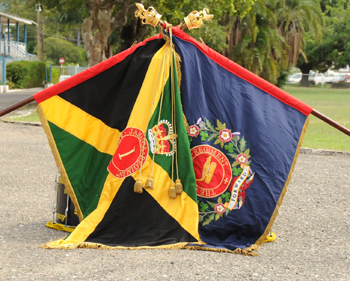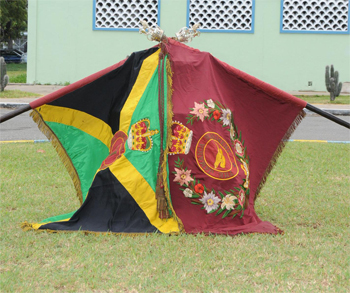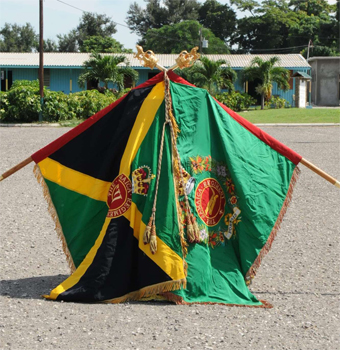|
History
BACKGROUND AND DESCRIPTIVE SUMMARIES OF
THE QUEEN’S AND REGIMENTAL COLOURS OF THE JAMAICA REGIMENT In battlefields of old, Regiments would form lines and advance against the enemy, literally shoulder to shoulder. Perhaps the greatest motivation driving scared men into imminent danger was the companionship of their comrades about them. It was this bond that epitomizes the regiment, as it still does today. Regiments needed a powerful visual symbol’ with which sometimes scared and confused soldiers could readily identify on the battlefield. It was to this that troops would rally and it was behind this symbol that line would advance. Standards and banners had been used for centuries in this regard; even the ancient Romans marched behind the symbol of an eagle. Tudor regiments did not serve the emperor or Queen, but their colonel. The colonel of the regiment was the founder and financial backer of private regiment and was as a figurehead, so it was his heraldic symbolism that was chosen to lead the regiment in battle as such the colours were born. A colour is the official ceremonial flag of a military unit (originally of an infantry unit only), and in this context it is sometimes used in the plural when referring only to a single flag. In the regiment of infantry of the British army and the armies of other commonwealth countries, each battalion carries two colours, which collectively are called a stand. These are large flags, usually 36 inches by 45 inches, and mounted on a pike which is 8 feet 2 inches in length. The King’s/Queen’s colour is usually a version of the country’s national flag. Often trimmed with gold fabric and with the regiment’s insignia placed in the centre. The regimental colour is a flag of a single colour, usually the colour of the uniform facings (collar/lapels and cuffs) of the regiment, again often trimmed and with the insignia in the centre. The Queen’s colour is the senior of the two. It is carried on parade only when a guard is mounted over a member of the royal family, His Excellency the Governor General and commander in chief or a visiting foreign head of state. It is only trooped for members of the royal family, He the Governor General and C-in-C and on occasion of ceremonial parades if the commanding officer so desires. Normal compliments are paid to the colours when marching on and off parade by all troops. The colours are always to be played on and off a parade to the tune of the regimental march. A regiment colours came to personify its ethos and, although they are nothing but sheets of embroidered silk, once consecrated they have come to be venerated and treated with reverence. On parade the colours will always be carried by a junior officer (an ensign) escorted by armed Senior NCOs. Even when cased in their protective leather covers they are marched under armed escort.
THE QUEENS COLOURS OF THE JAMAICA REGIMENT
The Queen’s Colour of the three infantry battalions comprising the Jamaica Regiment is designed with the Flag of Jamaica as the backdrop. The design and colour comprises a diagonal cross in gold with four triangles in juxtaposition; the top and bottom triangles are in green and the hoist and fly triangles are in black. In the centre of the colour is superimposed a crimson garter, itself encircled by two bands of fimbriation. The words "THE JAMAICA REGIMENT" are inscribed on the garter between the two circular bands of fimbriation while in the centre of the garter is superimposed the Roman numeral I, II or III (indicating the specific battalion). The fimbriation, letters and number are all in gold. Surmounting the garter is a representation of St Edwards’ Crown in gold and crimson. The Fringe is also in gold. It has two gold cords and tassels, and a pike with a metallic finial on top. The finial is a gold coloured cast replica of a Crowned Lion on a Crown. THE REGIMENTAL COLOUR OF FIRST BATTALION THE JAMAICA REGIMENT  The field is Royal Blue and in the centre is superimposed a crimson garter, itself encircled by two bands of fimbriation. The words "THE JAMAICA REGIME T" are inscribed on the garter between the two circular bands of fimbriation while in the centre of the garter is superimposed a Jamaican crocodile fess wise on a log; the crocodile, log, letters and fimbriation all in gold. Surmounting the garter is a representation of St. Edwards’ Crown in gold and crimson. The garter is surrounded in the centre by a wreath of Tudor Roses, Shamrock and Thistle. The wreath is open ended at the top to accommodate the St. Edwards’ Crown. At the bottom of the wreath is a scroll inscribed with the regimental Motto "FORWARD". The fringe is royal blue and gold. The Pike, cords, Tassels and Finial being the same as the Queen’s Colours.
The symbolism of the components of the Regimental Colour Crown: St. Edwards’ Crown is one of the British crown jewels. It has been used as a symbol of Royal authority in the Commonwealth realms since 1953. It is symbolic of the Monarch as Jamaica’s Head of State. Background colour: The Royal Blue is the colour of royalty and was selected as the identifying colour of the First Battalion, the Jamaica Regiment. Crocodile: The crocodile is a prominent element in the Coat of the Arms of Jamaica. It is indigenous to Jamaica and represents the strength and aggression required of an armed force. Motto: The Motto of the Jamaica Regiment is ‘FORWARD’. It indicates the determination, resilience and the drive for advancement in all things. The Tudor Rose: Here depicted to have five (05) petals of pink, red and white. The Tudor Rose, sometimes called the English Rose, is a traditional heraldic emblem of England and takes its name and origin from Tudor Dynasty and the end of the War of the Roses. It symbolizes the battalion’s link and proud ancestry with British Units of the Past. The Shamrock: The Shamrock is a three (03) leafed clover which is best known as the Irish Christian symbol of the Holy Trinity. Here it symbolizes the Unit’s belief in Christian values and the role of God in the life of the Battalion. The Thistle: The Thistle is a flowering plant characterized by leaves with sharp prickles. It is usually a symbol of nobility of character as well as by birth. Here it symbolizes the unit’s noble aims and pedigree. THE REGIMENTAL COLOUR OF SECOND BATTALION THE JAMAICA REGIMENT  The field is Maroon and in the centre is superimposed a crimson garter, itself encircled by two bands of fimbriation. The words "THE JAi.v1AICA REGIMENT" are inscribed on the garter between the two circular bands of fimbriation while in the centre of the garter is superimposed a Jamaican crocodile fess wise on a log; the crocodile, log, letters and fimbriation all in gold. Surmounting the garter is a representation of St. Edwards’ Crown in gold and crimson. The garter is surrounded in the centre by a wreath of Water Lilly, Periwinkle, White Easter Lilly, the Tudor Roses and water Reeds symmetrically disposed to the right and left, with the Fern closing the loop at the lower section. The wreath is open ended at the top to accommodate the St. Edwards’ Crown. At the bottom of the wreath is a scroll inscribed with the Regimental Motto "FORWARD". The fringe is Maroon and gold. The Pike, cords, Tassels and Finial being the same as the Queen’s Colours. The symbolism of the components of the Regimental Colour The Symbols and their significance • Background: Maroon, Unit colour • The fern: This is the foundation of the wreath and is commonly found in the Moneague area. It is used to symbolize our birthplace and first home, Moneague. •The bow tying the wreath together: A blend of maroon and gold, the Unit’s colours. •Crocodile on log: The emblem of the JDF • The Tudor Rose: A link with the past •The White Easter Lily: An emblem of purity and innocence which symbolizes christianity and our hope for the future. •‘Forward‘: The Regimental Motto • The crown: Symbol of loyalty to our Sovereign and Country • The Water Reeds: Found throughout Jamaica, and symbolizing water and our first operational task, the floods and the watery nature of Moneague. • The Water Lily or The Indian or African Lily: Said to be the Indian or African Lily. Whichever it may be, it symbolizes ‘our of many one people’, and also our home by the waters, Moneague. THE REGIMENTAL COLOUR OF THIRD BATTALION THE JAMAICA
REGIMENT (NATIONAL RESERVE)
 The field is Dark Green and in the centre is super-imposed a crimson garter, itself encircled by two bands of fimbriation. The words "THE JAMAICA REGIMENT" are inscribed on the garter between the two circular bands of fimbriation while in the centre of the garter is super-imposed a Jamaican crocodile fess wise on a log; the crocodile, log, letters and fimbriation all in gold. Surmounting the garter is a representation of St. Edwards’ Crown in gold and crimson. The garter is surrounded in the centre by a wreath of sugar cane leaves, on which are super-imposed Lignum Vitae flowers, Blue Mahoe flowers, and Ackees. The wreath is open ended at the top to accommodate the St. Edwards’ Crown. At the bottom of the wreath is a scroll inscribed with the Regimental Motto "FORWARD". The fringe is dark green and gold. The Pike, cords, Tassels and Finial being the same as the Queen’s Colours.
The symbolism and description of the components of the Regimental Colour
Crown: St. Edwards’ Crown is one of the British crown jewels. It has been used as a symbol of Royal authority in the Commonwealth realms since 1953. It is symbolic of the Monarch as Jamaica’s Head of State. Background colour: Dark Green is the colour selected as the identifying colour of the Third Battalion, the Jamaica Regiment (National Reserve). Crocodile: The crocodile is a prominent element in the Coat of the Arms of Jamaica. It is indigenous to Jamaica and represents the strength and aggression required of an armed force. Motto: The Motto of the Jamaica Regiment is ‘FORWARD’. It indicates the determination, resilience and the drive for advancement in all things. Wreath: Floral wreaths of varying design are common features in the regimental colours of many Commonwealth infantry units. It is customary for the wreath to embellish icons and artifacts that are unique to a particular unit. The following plants/flowers comprise the wreath of the Regimental Colours of the Third Battalion, the Jamaica Regiment (National Reserve). Sugar cane: Sugar cane or saccharum is a genus of six (06) to thirty seven (37) species of tall perennial grasses, native to warm temperate to tropical regions. They have stout, jointed, fibrous stalks that are rich in sugar and can grow up to two (02) to six (06) metres. This represents Jamaica’s principal agricultural product for a significant period of the country’s colonial and post colonial history and represents the link to the unit’s colonial ancestry. The Lignum Vitae flowers: The Lignum Vitae, Latin for “Long Life”, from which comes one of its common names, tree of life, is the National Flower of Jamaica. It is indigenous to Jamaica and grows up to seventeen (17) metres. The scientific name is “Guaiacum Officinale” and it is used here to represent the Battalion’s commitment to the preservation of the life and liberty of the people of Jamaica. The Blue Mahoe flowers: Hibiscus Elatus, affectionately called the Blue Mahoe, is the National Tree of Jamaica. It is indigenous to Jamaica and is found mainly in the wetter areas of the island. It grows up to twenty (20) metres in height. The tree’s huge and towering presence symbolises the enormous and sometimes seemingly insurmountable tasks the reserve unit is always ready to undertake. The Ackee: The Ackee, called Blighia Sapida in binomial nomenclature, is a member of the Sapindaceae (soapberry family) and native to tropical West Africa. It is related to Lychee and Longan, and is an evergreen tree that grows up to ten (10) metres tall. The flowers are unisexual and fragrant. They have five (05) petals, are greenish white and bloom during warm months. It was brought to Jamaica from West Africa in 1778 by Captain WILLIAM BLIGH. Despite previously losing his ship, the Bounty, to mutineers, once exonerated by the Court Martial inquiry, into the mutiny, he undertook again to transport breadfruit from Tahiti to Jamaica. It was during this voyage that he brought Ackee to Jamaica. Against this background the fruit symbolises the perseverance and indomitable will of the Battalion to be successful at all assigned tasks and to staunchly defend the constitution of Jamaica and strongly support due processes in all matters. |